page 24
Progressive Thinkers as of 5/8/2020
|
| ||||||||||||||||||||||||||||||||||||||||||||||||||||||||||||||||||||||||||||||||||||||||||||||||||||||||||||||||||||||||||||||||||||||||||||||||||||||
Interestingly, the recurrence of "three-patterned" organizational methods is far-reaching in biology and beyond.
For example, there also is the:
- Classification of animals by predominant food preference: Herbivores (plant eaters), Omnivores (plants and meat eater), and Carnivores (meat eaters). Guide to Herbivores, Omnivores, and Carnivores
- Classification of animals by symmetry of Body Plans: Radially symmetrical, Bilaterally symmetrical, Asymmetrical.
- Classification by basic observations of occupation: Land, Sea, Air
- 3-tiered Classification (Nomenclature of animals) system: Binomial, Trinomial (While "Mononomial" is not expressly used, it can be inferred as the general assignment of names given by everyday culturally-used references, like the old classification of forms noted as Animal- Vegetable- Mineral used by Carolus Linnaeus.
- Classification by body type (Somatypes): Ectomorphs, Mesomorphs, Endomorphs.
- Classified by type of collar: White collar worker, Blue collar worker, No collar worker
- Classified by social stratification: Upper class, Middle class, Lower class
- Classified by hair color: Brunette, Blonde, Red head.
- Classified by body dimensions: 36- 24- 36 (hips, waist, bust)
- etc...
But let me momentarily digress to provide some cultural "threes" ideas I have come across in the U.S., but may be more widespread (in other cultures) of which I am not aware of. For example, whereas some may note patterns-of-two with various parts of our bodies, we can find references to a third part:
- We have two eyes, but many children wearing glasses are called "four eyes" and there is the concept of the "third eye" which some have come to construe as
a reference to the Penal Gland. This 2- 3- 4 example can be explored further by noting alternative uses of this three-part ensemble: Devil's Advocate page 14
- Wikipedia: third eye
- Rolling My Third Eye: The Third Eye and Pineal Gland Connection by Shannon B. Jackson, 12-27-2020
- 10 Mysterious Facts About the Pineal Gland by Jordan Rosenfeld, Dec 26, 2016
- We have two ears but there exists the concept of The Third Ear by different people in their preferred subject area. Use of the "third ear" reference is often used to imply some exceptional quality of attentiveness or perception.
- We have the concept of a "third hand" in different ways and contexts. For example, a vulgar person wanting to make a joke about their penis may refer to it as their hungry hand. Another person may refer to their mouth as a third hand since it is used to hold items which may be used in succession. We also have a "third hand" reference to a person that expresses an opinion about a condition, consideration, content, coincidence or otherwise which may not be factual or partly factual with fanciful portions. Such a person may be referred to as a "third-hand witness" or someone who supplies third-hand information. Interestingly, we also have first and second-hand situations but no fourth-hand. (MacMillan Dictionary Definition: first?/?second?/?third hand).
- We have two legs, but on some occasions a person may refer to their penis as a third leg. However, in the "Riddle of the Sphinx": 'What goes on four legs in the morning, two legs in the afternoon, and three legs in the evening?'... The answer? Man, who crawls as a baby, walks on two legs as an adult, and uses a walking stick in his twilight years.
- With respect to having two arms, the notion of three arms appears to be projected outward, at least in one sense, when we say that the U.S. government has three arms (Executive, Legislative, Judicial): Three Arms of Government and Their Functions by Edeh Samuel Chukwuemeka ACMC, December 4, 2021.
- With respect to the idea of having three fingers, this is created by way of an illusion. By staring very closely to two fingers whose tips are touching, a third, middle finger appears to emerge.
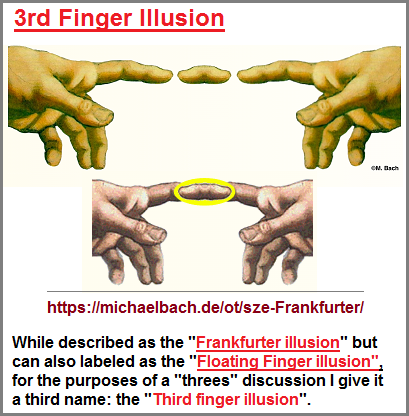
- While it is common to note a person has two nipples on their chest, there exists the concept of a third nipple which has alternative labels: (Why some people have a third nipple)
- Supernumerary nipples
- Accessory nipples
- Ectopic nipples
- Triple nipples
- Vestigial nipples
- The concept to "three feet" often comes into play by being referenced as a or the three-foot rule or three rules of thumb:
- Garbage cans, 3 feet from a curb and 3 feet from each other. (Different places appear to have different practices because not all places have curbs or the streets may be narrow, or differences in equipment.)
- Basically it implies that everyone close to you (within 3 feet if taken literally) is a prospect and you should attempt to market the Network Marketing opportunity to them. (3 foot rule, does it work? by Frank Ross)
- Three Foot World
- What does 3 feet for safety mean? (retrenching bicycles and vehicles) by Janet Lafleur, Oct. 29th, 2013
- 3 feet OSHA standard for electrical panel clearance
- In aviation, the rule of three or "3:1 rule of descent" is a rule of thumb that 3 nautical miles (5.6 km) of travel should be allowed for every 1,000 feet (300 m) of descent. (Rule of three (aeronautics))
- Three rules of thumb for back-of-the-envelope estimates by John D. Cook,1 July 2009.
- 6 Feet or 3 Feet: How Far Apart Do Students Need to Be? (Covid 19 distancing discussion by Sarah D. Sparks, Updated: March 16, 2021)
- Portable ladders not extending 3 feet above upper landing must be secured.
- While we have the sexual connotation of a person thinking with the wrong head (Thinking with the head of their penis), it should be noted that we also
have the common reference that two heads are better than one, there also exist references to the idea of three heads:
- Three Heads are better than two (Comparing learning properties and performances across individuals, dyads, and triads through a computational approach. by Tsutomu Harada, June 17, 2021)
- Japanese Proverb: Three Heads Are Better Than One
- Three heads are better than one: Cooperative learning brains wire together when a consensus is reached. by Yafeng Pan, Xiaojun Cheng, Yi Hu
- Third gender concept
- Three- to- one blood typing. Whereas it is called the (three-lettered) ABO blood typing system, the "odd man out" profile is the AB. Hence, we have the A, the B, the O, and the AB types. ABO Grouping
Yes, yes, yes. I know I ventured into Sociology and cultural views of human characteristics when initially providing examples of threes from physics. And yes, I know there are other kinds of classification which may be use that are less than or greater than the value "3". However, the "three" remains a dominant and popular means of organization used by different people in multiple contexts. And yes, if you choose another number you may well find it being used in some context, but those contexts may not be serious items such as describing Earth as the 3rd planet and not the 1st, 2nd, 4th, 5th, 6th, 7th, 8th, 9th, etc... Something must not only be said for the repetitious use of the "three" in multiple serious topics, but the use of other patterns as well... all of which exhibit small values when calculated according to the frequency of appearance and diversity of application in different subjects.
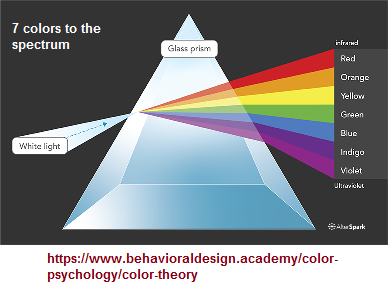
Saying you are the 7th son of a seventh son of a seventh son displays not only a recurrence of the "7" value, but also the three in terms of biological succession. This example is not as important as pointing out that the spectrum of colors is seven in quantity. And though the value of "7" captures the attention and imagination of some people, we do not find this value as prevalent in ideas as we do the values 2 and 3. We don't find 7 large atomic particles, we find three (Protons- Neutrons- Electrons). While you may come across the idea that we have 7 layers of skin, looking in a textbook we find that three are routinely listed (Epidermis, the top layer. Dermis, the middle layer. Hypodermis, the bottom or fatty layer.) While we can indeed classify skin having seven layers, we need to place this idea into context: The first five layers of the skin are part of the epidermis, and next two layers comprise the dermis.
While you may be one to assert the value of "7" by listing the color prism and skin layer examples, you must support your claim with additional examples, none of which actually devalue the presence of the "3" or "2" in an effort to assume some position of cognitive superiority. And while you are pressing for the "7" as being THE most important number, please take time to make an assessment of all the number patterns being used in order to create separate columns of information which will list both the quality and quantity of examples for all the number patterns being found. And yes, this includes all examples that you or anyone else wants to deliberately search for and "read-into" a given expression or reference. What you will find (or at least should find), is that the quantity of numbers we humans are using for our classification and compositions is but a handful, when compared to the infinity of numbers at our disposal. It's not that we aren't capable of thinking in large numbers, but the brain of humans is mimicking the patterns it observes in Nature. We do not find Nature using large numbers with the frequency and dispersed application found to be the case for small numbers.
This phenomena is what I am calling a "Conservation of Number". We are being force to comply, to imitate small number uses as a survival mechanism, just as Nature does such as in the case of a Triplet code for DNA. Why not a Quadruplet code? Why not a Quintuplet code? Why not a Gazillion code? Is Nature itself subjected to pressures we humans have not identified (perhaps because they have not been on our radar screen of contemplations)? Does the Universe require a 3rd planet placement so that certain conditions are optimized for a particular type of biological genesis to occur, and that as the Sun expands during its incremental burnout, the planet Mars will then achieve the position in the planetary system making it most suitable for life? Hence, a study of the recurring patterns of thought and exercised activities may be useful in determining how restricted the human mind is in its ability to conceptualize, since it may be predisposed to use a given pattern which may change over time if it is a reflection of an alterable survival mechanism highly reflexive to incremental deteriorations such as the Sun burning out, the Earth's rotation slowing (as calculated from its once fast spin billions of years ago), and the Moon receding... not to mention all the man-made decreases in resources on the planet Earth.
The observation of number patterns being used repeatedly, can well be interpreted to be Cognitive Standards. But we should not view the word "standard" to mean forever or even commonplace, as suggested by the use of different pattern numbers holding more importance in one culture (or sub-culture, or institutional/business/government/religious/ culture) than another. The uses of some numbers as observed patterns appear to transcend time and place, while others diminish, others crop up, and some may seem to almost entirely vanish from their once dominant usage. Everything we do and do not do can be rendered into a number. Just because we do not use the numerical symbols doesn't mean there is no underlying numerical pattern to be identified, whether or not we are engaging in self-deception or not. Another researcher will come to identify our false evaluation, though they may be involved with another pattern number preference which renders them biased.
There are multiple other examples of "threes" from diverse subjects which have been collected by many others at different times and places. While some prefer to collect examples from a single subject, others like myself prefer a more eclectic (very broad) approach. This site exhibits an ongoing collective effort. I take examples from multiple sources and make an attempt to provide each and every author with their due credit. I in no way want to pass off their work as my own. Plagiarism is foolish since you would be found out for any deception eventually. However, like many of you I notice that there are other pattern numbers such as 1, 2, 4, 5, 6, 7, 8, 9, etc... Yes, on occasion we will find an absence of a "three pattern" and forced to confront the situation in which some other number re-occurs with a frequency that can not and should not be brushed aside. In an attempt to account for them, one might suggest that all of them constitute some measure of standardness in human thinking, but that some numbers arise with greater frequency in different forms. Whereas we do not always see the symbol "3" or some other numerical symbol, the pattern may show up as a single word such as one, or two, or three, etc... Very often I have found that numerical patterns can occur in multiple shapes, sizes, flavors, etc., depending on a person's language, culture, and interests. But many number patterns appear to be universal, in that most... if not all humans rely upon them just as we do with having a similar physiology and genetics. Indeed, all life is on the 3rd planet from the Sun and not some other numbered planet. While there may be other types of life forms elsewhere in the Universe which do develop on a planet (or whatever) that is not in a 3rd position, we at present do not know of any.
While there are standards of thinking to be found amongst different cultures, different language groups, genders, religious orientation, etc., it is of need to find more basic representations of enumeration which occur in human thinking. For example, all people rely on a period, question mark and exclamation point for ending one sentence (expression) or another. This is a standard cognitive pattern. Again, different cultures may exhibit what can be described as a cognitive (mental activity) standard which is (or may not be) expressed in some manner, be it by an activity of art, craft, music, science, mechanics, cooking, gardening, fishing, etc... Whereas one standard in one culture may be actively used as a commonality such as the idea of the Yin/Yang philosophy which exhibits multiple patterns-of-two sometimes referred to as dualities, dichotomies, opposites, complimentarities, partners, etc.., the use of a visual list may be helpful for those unfamiliar with the idea:
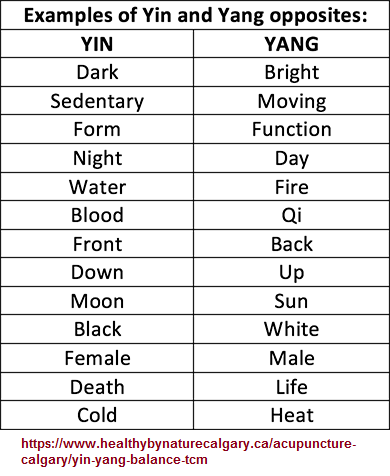
The idea of the yin and yang has been applied to different interests such as foods:

The yin and yang idea has also been applied to management practices which emphasize three core concepts:
- Cycles move from one extreme to the other (night ends as day approaches)
- All things are interconnected and dependent on one another
- Balance is an ongoing process of ebb and flow
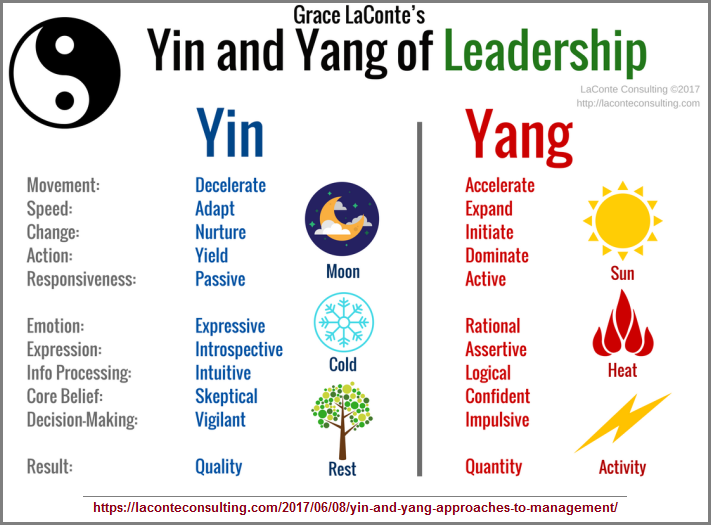
Even though the idea of the Yin and Yang list of paired ideas has been applied to multiple interests, let us not forget that it is a Natural philosophy constructed by humans and is not necessarily a philosophy of Nature. I am inclined to view it more as a symbolic representation of a fundamental pattern construed the human brain by way of a simple form of counting called pairing, initially linked to an observation of differences noted between genders. In other words, it is an enlarged... an embellished philosophy initially developed by what we today may refer to as a sexual or sexuality differentiation. Granted that it may have begun as a simple reference to the acknowledgment of gender differences, but it has come to express a much larger system of counting multiple observations using a counting system of pairing. Instead of making notches on bones, rocks, shells or what have you; the yin and yang philosophy is a series of paired notches that was eventually subjected to an increased model of intellectual activity called the I-Ching, which exhibits an orientation towards patterns-of-three called triads. The notches (words) used on a list of yin yang items is like a rudimentary form of mathematics where one side of the equation is matched to the other side of the equation in some symbolic manner. However, it was not in the East where our present mathematics became further embellished, but in the West. To this end, the dominant pattern-of-two ideas to be found in Mathematics is a Westernized embellishment of the old yin/yang system of pairing... which is a rudimentary form of counting by pairs.
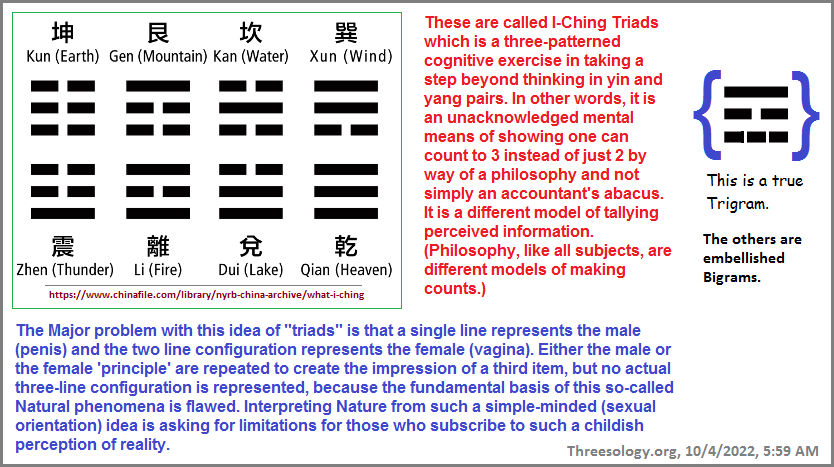
While the idea of I-Ching Triads has been philosophically embellished ("complexified") as described here: Group relations, resilience and the I Ching by Frank Schweitzer, it is of need to point out that it too represents an early form of counting where the idea of a "group of three" was conceptualized as an intellectual step beyond the patterns-of-two seen in the yin/yang philosophy, an actual state of "three" was not achieved... and in fact what we find is an embellished pattern-of-two set into a three-patterned array, which one would expect as an activity in developmental terms, though occasions of exercising a "leap" in human cognition is not unheard of, much like a "punctuated" form of evolution (or equilibrium) taking place (perhaps more commonly known as a mutation which exhibits something extra- than an ordinary capacity or activity). Simply put, the so-called I-Ching triads are not actual pattern-of-three, but attempts to reach such a formula by way of elaborately concealing patterns-of-two set into a configuration whose complexity and attenuations to other considerations helps to camouflage the basic pattern-of-two being clothed in a lacy garment.
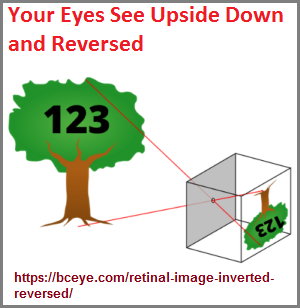
Our present day Mathematics is a Westernized embellishment of a basic pattern-of-two orientation developed in ancient China. Yet, because humans seem only to be able to process large amounts of divergent data by using a simple activity such as pairing, this may account for the adoption of such a pattern to multiple types of observation from which ideas are constructed... because human perception does routinely process in groups of three on a large scale as a practice that is applied to different subjects as a whole, though individual characteristics within a given subject may well have multiple patterns-of-three ideas that are not routinely collected together and assembled into an idea involving human cognitive development and behavior over place and time. Whereas we see patterns-of-three groups in particle physics, we rely on a two-patterned electrical formulation from which has been developed a binary code used for computers. A predominantly two-patterned fashioned system of Mathematics that humanity currently makes use of only serves to focus attentioned ideas in a similar direction, despite attempts to develop a trinary dominant computer system. Humanity has difficulty in thinking outside the two-patterned box in lives in because it is a very deep and wide box with multiple two-patterned tunnels from which arise multiple two-pattern ideas which make perfect sense to a mind whose developmental educational foundation has been impressed upon with a dominant two-patterned orientation in many different guises. One of these is the notion of a "Wavicle" (Wave–particle duality) created by the use of a two-pattern double-slit experiment, particular since the process of seeing rests upon ideas involving a pattern-of-two reversed image notion occurring in the brain's visual field of activity. (Your Eyes See Upside Down and Reversed by Gregory H. Scimeca, M.D., Nov. 11, 2019)
On the one hand we have the record of a double-slit experiment: (Double-slit experiment) and a triple-slit experiment: (Triple-slit experiment confirms reality is quantum by David Shiga, New Scientist (Physics), 22 July 2010.) Both of which are used to confirm other ideas involving quantum mechanics, but a "reverse-engineering" mode of thinking where we start from the experimental side of the equation, may not necessarily yield the ideas used as an influence on the type and manner in which the experiments are carried out. In other words, as indicated in the previous line of thinking concerning the use of a patterns-of-two thinking model whether acknowledged as such or not, if there is a mental inclination which impresses upon a person to use a pairing form of orientation, then the result of a wave/particle duality is easily understood. However, this then implies that such a concept is a rudimentary form of mental counting activity and we are awaiting someone to create the notion of a third participant in this two-part result, even if the expression is at first but an embellishment of the wave/particle duality and is not an actual three-part configuration.
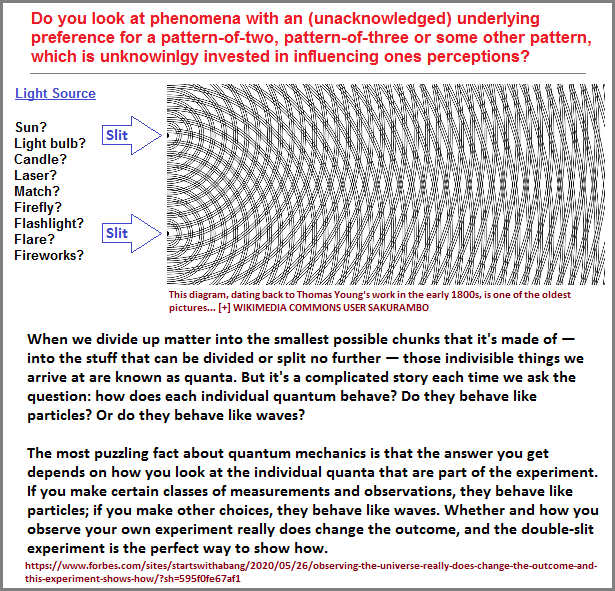
Even though Thomas Young used an overall three-part configuration, the idea of "three" is not at the forefront of conversation. The "two" is in the form of wording indicated as "double"-slit experiment. If the human brain has an underlying "2" count that some people (and institutions like Religion and Politics) become transfixed on and do not allow for a higher count in their consciousness (because such people gravitate to such types of institutions to assert their antiquated ideas?), then social standards may well be an exercise in contentions between those who are predominantly two-patterned oriented and those who are transitioning into a three-patterned consideration.
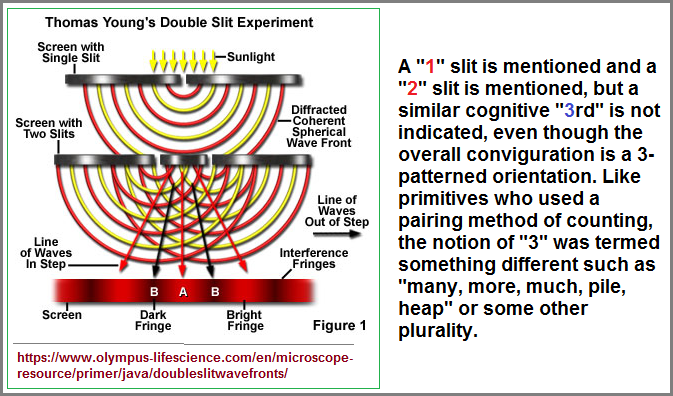
If we look at Thomas Young's experiment as a cognitive exercise of pairing (or a two-patterned mental exercise), let us note that others using their own methodologies in reviewing Young's work, also rely on simple experimentally exercised counts:
The success of Young's experiment was strong testimony in favor of the wave theory, but was not immediately accepted by his peers. The events in place behind phenomena such as the rainbow of colors observed in soap bubbles and Newton's rings (to be discussed below), although explained by this work, were not immediately obvious to those scientists who firmly believed that light propagated as a stream of particles. Other types of experiments were later devised and conducted to demonstrate the wave-like nature of light and interference effects. Most notable are the single mirror experiment of Humphrey Lloyd and the double mirror and bi-prism experiments devised by Augustin Fresnel for polarized light in uniaxial and birefringent crystals. Fresnel concluded that interference between beams of polarized light can only be obtained with beams having the same polarization direction. In effect, polarized light waves having their vibration directions oriented parallel to each other can combine to produce interference, whereas those that are perpendicular do not interfere. (Thomas Young's Double Slit Experiment)
Use of a single mirror or double mirror experiments are exercised models of mentally counting with small numbers, as can be seen in the use of a double-slit experiment, yin/yang compilation of examples, psychology (Persistent Dichotomies), and Mathematics (with such dualities as add/subtract, multiply/divide, real number/imaginary number, two sides of an equation, philosophy (Dualism and Mind by Howard Robinson, Substantive Revision: Fri Sep 11, 2020; The Implicit Duality of Thinking by George P. Conger, Apr. 27, 1922 etc...). When we say that someone is giving an "account" of some subject, indeed they are. They are expressing a model of counting which may contain several "modules" of underlying numerousity such as if they were expressing items in parenthesis. brackets or braces as one might see in an equation, but has foolishly been isolated to thinking that such behavior only occurs in mathematical expressions when it in fact occurs in all types of thinking in different ways:
In math, it is important to separate groups of numbers for many reasons, such as grouping coordinates or writing sets. Depending on the type of mathematical grouping, there is the different notation: (Order of Operations with Brackets, Braces, and Parentheses)
- Parentheses, ( ), are the most common type of grouping notation used in mathematics.
- Brackets, [ ], are a squared version of parentheses.
- Angled brackets, < >, due to their similarity to the greater than and less than symbols, they are only used to designate a set of numbers which is a vector.
- Braces, {}, these are a curly parenthesis.
- Braces and brackets can both be used to separate groups of values for the arithmetic order of operations. The difference between braces and brackets in math is that braces can also be used to indicate a set, or a collection of related values, while brackets can also be used to signify that a group of numbers in an array, or a collection of numbers arranged in rows and columns.
- Parentheses, like brackets, are also used for the order of operations, and if layers of separation are required, they are used to illustrate the first grouping that needs to be evaluated, while brackets imply a secondary grouping of values. The difference between brackets and parentheses in math is that parentheses are also used to denote coordinates, multiplication and whether or not a value is included in interval notation.
One might as well ask a person what type of accounting method their brain uses when we ask them their preferred subject of study, since each subject is one type of an account of given material and associated ideas. While some simple accounting methods of pairing are necessary survival tools such as pairing pain with sticking one's hand in a fire, we must be cognizant of the very real possibility that such a primitive pairing behavior can be held over onto other situations later in life which act as obstacles from thinking outside conventional boxes of two-patterned orientation. Yet, if your mentality sees the value 2 (in whatever form and formula your vocabulary is inclined to use) as being foremost and anything beyond the "two" (duality, dichotomy, etc...) is a redundancy, superfluidity, more-of-the-same, etc., then the realization of an actual third may not be part of your consciousness, and you make due with what mental accounting method is most comfortable. If you don't know of the value 3, for example, then trying to explain that a 2 is not the foremost to be realized may not have any meaning for you. You will continue to use the same crude two-patterned toolage you have always done and use to interact with others who share in this accounting methodology, whereby conflicts with those who can count higher (in a conceptual and not strictly a numerical sense) will counting because you may never achieve a reality of being on the same page of conceptualization, and prefer to maintain the status quo of yourself and those who think as you do... established as tradition, as law, as belief, as custom, as fashion, or otherwise.
There is at least one thing to be derived from a study of threes (ideas, activities, events, etc., which come in groups or sequences of three) which have led me towards pursuing the notion of a Standard Cognitive Model. Whereas one might initially attempt to secure the view about the consistent repetition of views involving some model of a pattern-of-three, it has allowed me... that is, forced me to take stock of non- patterns-of-three that I have alternatively described as an absence of the "three". I have also come to realize that the "three pattern" is not always viewed by some as being the most prominent characteristic chosen by everyone, though its presence can not be doubted. If you are asked to select your most favorite number amongst a list of numbers from zero to nine (0- 9), the one chosen may in fact be the pattern you prefer to see in all, most or many types of information. You may knowingly or unknowingly selectively orient yourself towards a given numerical preference even if the number symbol is not used. The structure of letters, words, a sentence, a paragraph or enclosed information may be aligned with a preferential numerical value, much like someone who arranges a bathroom set of towels on a rack in a small, medium, large sizing sequence.
Date of (series) Origination: Saturday, 14th March 2020... 6:11 AM
Date of Initial Posting (this page): 1st March 2022... 6:04 AM
Updated Posting:Saturday, 15th October 2022... 6:38 AM, MST; Albuquerque, NM.